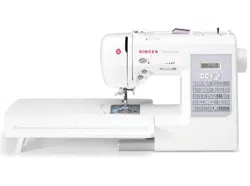Loading ...
Loading ...
Loading ...

48
1 2
1 2
4
3
Mediumtoheavyweightfabric
Materialdepesomedioapesado
Tissus moyens et lourds
Under side
Reverso
Envers
Under side
Reverso
Envers
Under side
Reverso
Envers
Under side
Reverso
Envers
Fine fabric
Materialno
Tissusns
Top side
Cara
Endroit
1. With matching thread finish the raw edge. On fine fabric
turn up and press a small ½” or less hem. On medium to
heavyweight fabrics overcast the fabric’s raw edge.
2. Now fold the fabric as illustrated with the wrong side up.
3. Place the fabric under the foot. Turn the handwheel
towards you (counter-clockwise) by hand until the needle
swings fully to the left. It should just pierce the fold of the
fabric. If it does not, adjust the guide (B) on the Blindhem
Foot (A) so that the needle just pierces the fabric fold and
the guide just rests against the fold.
Sew slowly, guiding the fabric carefully along the edge of
the guide.
4. When completed, the stitching is almost invisible on the
right side of the fabric.
BLINDHEM STITCH
Settings : Presser foot - Blind stitch foot
: Thread Tension Control: AUTO
The blindhem stitch is primarily used for creating nearly
invisible hems on curtains, trousers, skirts, etc.
A
B
NOTE: It takes practice to sew blind hems. Do a
test sew rst.
NOTE: In addition to the adjustment on the foot,
the stitch width control can be used. The stitch
width control changes the swing of the needle for a
narrower or wider stitch.
-
Regular blind stitch for normal woven fabrics
-
Elastic blind stitch for soft, stretchable fabrics
Loading ...
Loading ...
Loading ...
